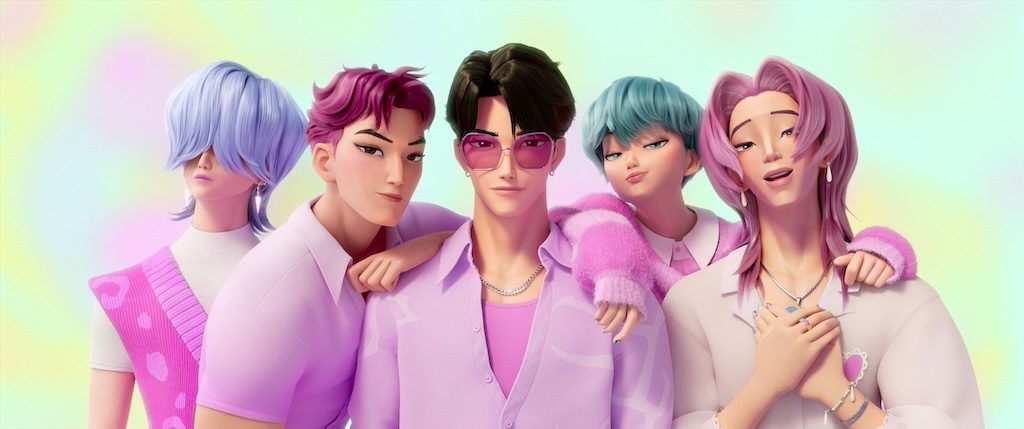KPop Demon Hunters: A Cultural Phenomenon Forged in Korean Myth, Music, and Motion

It all started with an off-the-cuff one sentence idea followed in 2021 by the memorialized phrase by Maggie Kang, ‘This will never get made.” Sony Pictures Animation disagreed and bought the pitch soon after – KPOP girl group by night, demon hunters by day. The aren’t filling stadiums like they used to, so a side hustle is necessary. KPop meets Kombat.
Kang calls the movie her “love letter to KPop and my Korean roots.” Joined by co-director and screenwriters Hannah McMechan and Danya Jimenez, KPop Demon Hunters was brought to life.
Rooted in Korean Culture
KPop Demon Hunters isn’t a genre mashup or a gimmick. It is deeply-steeped in cultural lore.
From the outset, cultural authenticity guided the process. Kang and Appelhans immersed themselves in Korean folklore, shamanism (like jeoseung saja, dokkaebi), demonism, and ritual arts to ground the narrative in tradition.
The HUNTR/X Show stars pound out their infectious hits like How It’s Done, Takedown, Golden, and Free to illuminate the thematic and narrative spine of the film – who are these KPop stars and where do they fit into the Korean-American mosaic.
Much like other super heroes, they keep their true identities secret while they save the world. They are goofy, flawed, teenagers who mess up, and occasionally say hurtful things to each other which they later regret.
As background, long ago, demons preyed on humans, feeding their souls to their ruler Gwi-Ma. Eventually, three women (HUNTR/X) became demon hunters and kept the demons away with a magical barrier called the Honmoon. Taht is, until a rival boy band Saja Boys (Saja means lion in Korean), a rival KPop group of disguised demons enters the fray.

Mira (May Hong), Rumi (Arden Cho) & Zoey (Ji-young Yoo) Photo courtesy of Netflix
Character Profiles
HUNTR/X
Rumi (Arden Cho) The charismatic leader and lead vocalist. Half‑demon and battling inner shame, she struggles with losing her voice—until she realizes embracing her dual nature gives her song power. Rumi’s arc is one of acceptance, identity and redemption.
Mira (May Hong) The main dancer from a wealthy, but unconventional background. She wields a traditional gokdo polearm, balances cynicism with loyalty, and helps ground the team emotionally.
Zoey (Ji-young Yoo) The youngest member raised in Burbank, wields shinkal ritual knives. She’s free-spirited, emotionally intuitive, and crucial in bridging human and spiritual worlds within the group.
The Saja Boys & Gwi‑Ma
Jinu (Ahn Hyo-seop) Lead of the Saja Boys and former human turned demon, partially inspired by EXO’s Kai. His charisma and performance mask deeper self-loathing—becoming a powerful mirror for Rumi’s own struggles.
Gwi‑Ma (Lee Byung‑hun) The demon king whose strategic manipulation of shame and supernatural corruption fuels the conflict.
The remaining Saja Boys are Romance Saja, Mystery Saja, Abs Saja, and Baby Saja who ably assist.

The Saja Boys. Photo courtesy of Netflix
Central Themes: Identity, Shame, Music, and Community
KPop Demon Hunters balances pop culture, mythic undercurrents, with deeper themes.
- Identity and self-acceptance: Rumi’s conflict between her demon heritage and idol expectations underscores the challenge of being oneself in curated public life. Jinu’s storyline illustrates this theme—the film shows how both shame and acceptance shape her identity.
- Shame and redemption: Villains like Gwi-Ma prey on guilt, while heroes must forgive themselves to triumph. Gwi‑Ma weaponizes shame through songs and psychological manipulation. Redemption in this world isn’t punishment—it’s discovering courage to face your own inner darkness—and converting it into something creative, communal, and powerful.
- Power of music and fandom: Songs aren’t mere set-pieces; they fuel the Honmoon demon protective barrier. Fans collectively influenc them. KPop Demon Hunters reimagines music as modern shamanism.
- Duality of public vs. private selves: Balancing onstage glitz with off-stage battles highlights the gap between perception and reality, a universal tension that resonates with viewers.
- Female Empowerment & Imperfection: HUNTR/X are “perfectly imperfect”: they burp, they sass, they drop the ball—but rise stronger together. Kang emphasizes wanting funny, emotional, flawed heroes—free of polished superhero tropes.
- Cultural Legacy & Spiritual Heritage: The story of past generations of demon hunters, Rumi’s ancestral legacy, and symbolic weaponry establish heritage as an active force.
- Mental Health Resonance: The film addresses anxiety, burnout, obsession, and performance pressure. Characters find healing, not in perfection, but community, honesty, and shared purpose—echoing broader conversations around mental wellness in idol culture and everyday life.
- Layered character arcs: Each protagonist wrestles with a personal flaw tied to the central metaphors (voice loss, shame of heritage, creative insecurity). Their growth feels earned and mirrors the film’s core message of self-acceptance.
KPop Demon Hunters stimulates the senses with a rich excavation of Korean mythology, blended with current teen pop culture and all the social and emotional baggage that come with it. The themes of identity, deciding what you want in life and being true to it, and your place in society are both universally-relevant and culturally-specific.
Join the Discussion!
Related Articles
Browse our Videos for Sale
[woocommerce_products_carousel_all_in_one template="compact.css" all_items="88" show_only="id" products="" ordering="random" categories="115" tags="" show_title="false" show_description="false" allow_shortcodes="false" show_price="false" show_category="false" show_tags="false" show_add_to_cart_button="false" show_more_button="false" show_more_items_button="false" show_featured_image="true" image_source="thumbnail" image_height="100" image_width="100" items_to_show_mobiles="3" items_to_show_tablets="6" items_to_show="6" slide_by="1" margin="0" loop="true" stop_on_hover="true" auto_play="true" auto_play_timeout="1200" auto_play_speed="1600" nav="false" nav_speed="800" dots="false" dots_speed="800" lazy_load="false" mouse_drag="true" mouse_wheel="true" touch_drag="true" easing="linear" auto_height="true"]










You must be logged in to post a comment Login